Eye: Medicine
Dog Ear QuickLinks
Formulations and Routes of Administration for Eye Medicines:
For any condition, there are different routes of administration, which should be selected according to the condition and diagnosis. For dog eye conditions, there are three different routes of administration, i.e. topical, local or systemic.
Drugs are either administered through an oral route – as in cases of generalized illness such as fever. But for dog eye problems about 80% of medicines are administered through a local or topical route with administration directly into the eye.
Since dog eyes are delicate organs, local or topical eye medicines are specially specially formulated to work with the physiology of eye, i.e. in the form of eye drops, eye ointments, eye pads etc. These formulations contain an isotonic solution or buffering gel, combined with specific therapeutics such as antibiotics, corticosteroids, anti-inflammatory drugs, pain killers, pupil dilators/constrictors, anesthetics etc.
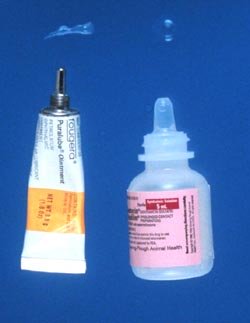
Dog Eye medicines
usually are in the form of dog eye drops or dog eye ointments. The
ointments last longer in the eye, so need to be applied with less
frequency. The type of eye dog medicine varies based on the
specific diagnosis and dog eye condition.
Source: Washington State University (all
pictures on page)
In most dog eye medicines, the base or primary therapeutics are combined with an isotonic solution, which can be separately used as a dog eye wash solution.
Types of Dog Eye Medicine:
Dog eye medicines are administered to treat specific conditions such as infections, to reduce inflammation, to eliminate or reduce pain and to regulate tear production. Similarly, other drugs may be used to reduce pressure over parts of the eye, to heal any injury and to manage abnormalities in focusing and dog eyesight.
The following are different types of drugs, which are usually formulated as dog eye medicines;
-
Antibiotics: Antibiotics are specific drugs, which are
administered locally (directly into the eye) in
the form of drops and ointments locally, and in the form of tablets and
syrups
if administered orally. Dog antibiotic eye drops usually contain one or
more antibacterial agents, administered according to the confirmatory
diagnosis.
Different groups of antibiotics such as Aminoglycosides, Tetracyclines and Fluroquinolones have been effectively used for treating dog eye infections. Different specific antibiotics such as oxytetracyclines, Bacitracin, neomycin, chloramphenical, erythromycin, gentamycin, polymyxin B, tobramycin etc are used individually or in combination for treating different species of bacteria that cause dog eye infections.
- Corticosteroids: Corticosteroids are used to reduce dog eye inflammatory response, thus symptoms of pain, redness, swelling, partial blindness and elevated temperature around dog eyes can be treated effectively. Different corticosteroids such as prednisolone and dextamethasome can be used in the eyes, but care is needed in terms of setting the dosage. Corticosteroids should never be used for dog eye ulceration or in viral or fungal infections before healing starts. Therefore, it is important to only use corticosteroids with a prescription and only after receiving a confirmatory diagnosis from a veterinarian.
- Atropine Sulfate: Atropine sulfate is
used to dilate or widen the eye
aperture. Eye medicine dog containing atropine as a base are used for
dilating dog eyes during injuries, for surgery and in order to treat
canine glaucoma. Eye dilation helps when operating during surgery and
when treating trauma. In canine glaucomas cases, dog eye pressure can
be
be reduced on the base of
the eye.
Care should be taken when administering atropine. For example, it should not be administered to dogs with primary or severe canine glaucoma or those that are sensitive towards atropine. Similarly, once a dog is administered atropine in the eye, the dog should be kept in a dark environment and the eyes should not be exposed to bright light.
- Cyclosporines: These are ophthalmic preparations used to alter the immune response in canine eyes, i.e. reducing the chance of a severe immune response. It is usually prescribed in cases of Keratoconjunctivitis sicca or a dog dry eye condition.
- Synthetic Tears/Buffers: These are formulated as dog eye drops and ointments, used to replace or for ensuring adequate tear/lubricant supply over the eye surface. These are used either to support the eye during reduced tear flow over the surface of eye or for a dog dry eye condition. These special formulations are also used during surgery to keep the surface of the eye lubricated and moist. Buffered drops can also be used as a regular eye washing solution as well.
- Natural Remedies: Natural or herbal extracts are other ways to support dog eye health. Commercially available natural dog eye drops such as Eye Heal or dog eye area cleaning solutions such as i-Clenz can be effectively used to either treat minor eye conditions or to support specific therapeutics during the healing process. These remedies usually do not require a prescription and can be even more effective when used along with prescribed dog eye medicines.
Applying Dog Eye Care Medicine
Eye medicine dog is usually applied via an ointment or liquid solution such as drops administered directly to the eye. To apply these types of solutions, lay your do on a table, standing on the side opposite the eye. Lean over the dog as indicated with the right arm draped over the dogs shoulders. Hold the muzzle with the left hand and pull down the eye lid. Apply the drops or ointment with your right hand. Do not touch the dog eye with the tip of the dog eyes medicine container..
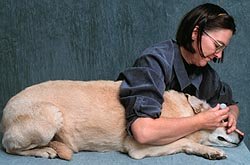
Applying Dog Eye Care
Medicine
When holding the dogs head in the left hand (for righties, hold with right hand if left handed), with your thumb, pull down the dog lower eye lid. This will form a pouch. Keep the tip of the medicine several millimeters from the dog eye surface (do not touch the eye). Apply the ointment with a slight squeeze on the container, and let it fall into the pouch you created by lowering the dog eye lid.
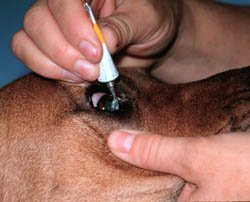
Eyes Medicine
Pet Application
When applying eye medicine dog that is in the form of an ointment, it can help to massage the eye when the eyelid is closed. Ask your veterinarian about the proper technique to use when applying dog eye medicine such as ointment.
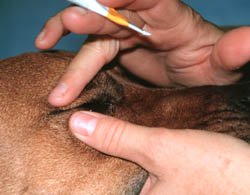
Medicine
Massage After Applying Ointment
Dog eye drops are also placed into the pouch you create when pulling the dog lower eyelid. Be sure to hold the dogs head and apply the exact number of drops prescribed. It might help to rest the heal of the hand on the head in order to be more steady and to avoid poking the eye with the tip of the bottle.
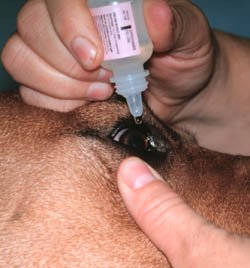
Applying Dog Eye
Drops
If the dog tries to get up, have one person lean over the dog in the center, with one arm over the hips and the other over the shoulders. Hold the dogs legs close to the body and this makes it harder for the dog to get up, than if you held the legs near the paws.
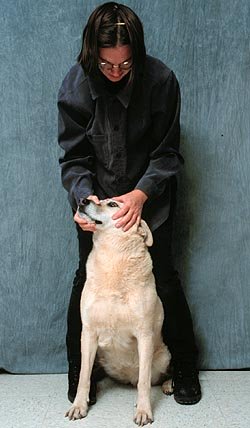 |
For large dogs, try leaning against a wall holding the dog between the legs while the dog is in a sitting position. Hold the dog head in the direction opposite the person applying the dog eye drops or dog eye ointment. |